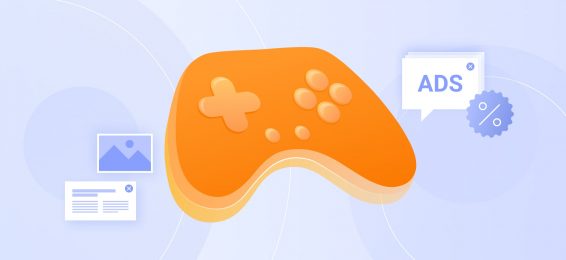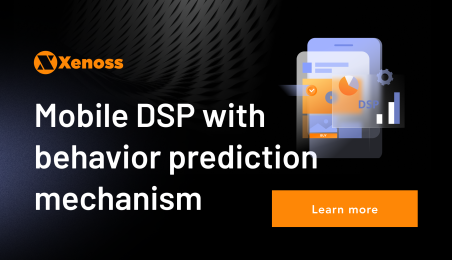The mobile in-game advertising market is set to hit $56 billion in revenue by 2024 — that’s 13X more than in 2019. The number of gamers globally is also poised to reach 3.32 billion by 2024.
The above is great news for mobile app publishers and developers alike. But many are missing out on the growing profits due to the complexities of technologies in the mobile game monetization market.
Most in-app ad inventory is monetized through “ad waterfall” — a method that doesn’t support dynamic eCPM adjustments. Instead, the ad network fills ad requests at a minimum price set by the publisher.
The above is a sharp contrast to web programmatic, where advertisers can bid in real-time on available inventory. Publishers can utilize an array of selling methods for different inventory to pick the option with the highest yield.
How can mobile publishers also benefit from real-time bidding and capture more revenues? With a custom mobile ad mediation solution.
In this article we explain:
- What ad mediation is and what type of mediation solutions are currently available
- The main challenges of integrating an off-the-shelf ad mediation tool
- The benefits of building a custom ad mediation solution
- Best practices for developing a robust mobile ad monetization suite
What is ad mediation?
An ad mediation solution lets you manage multiple ad networks (and access more ad selling models) through a single software development kit (SDK).
An ad mediation SDK, in turn, is a standardized set of development tools for incorporating several ad serving options through one connector embedded into your app.
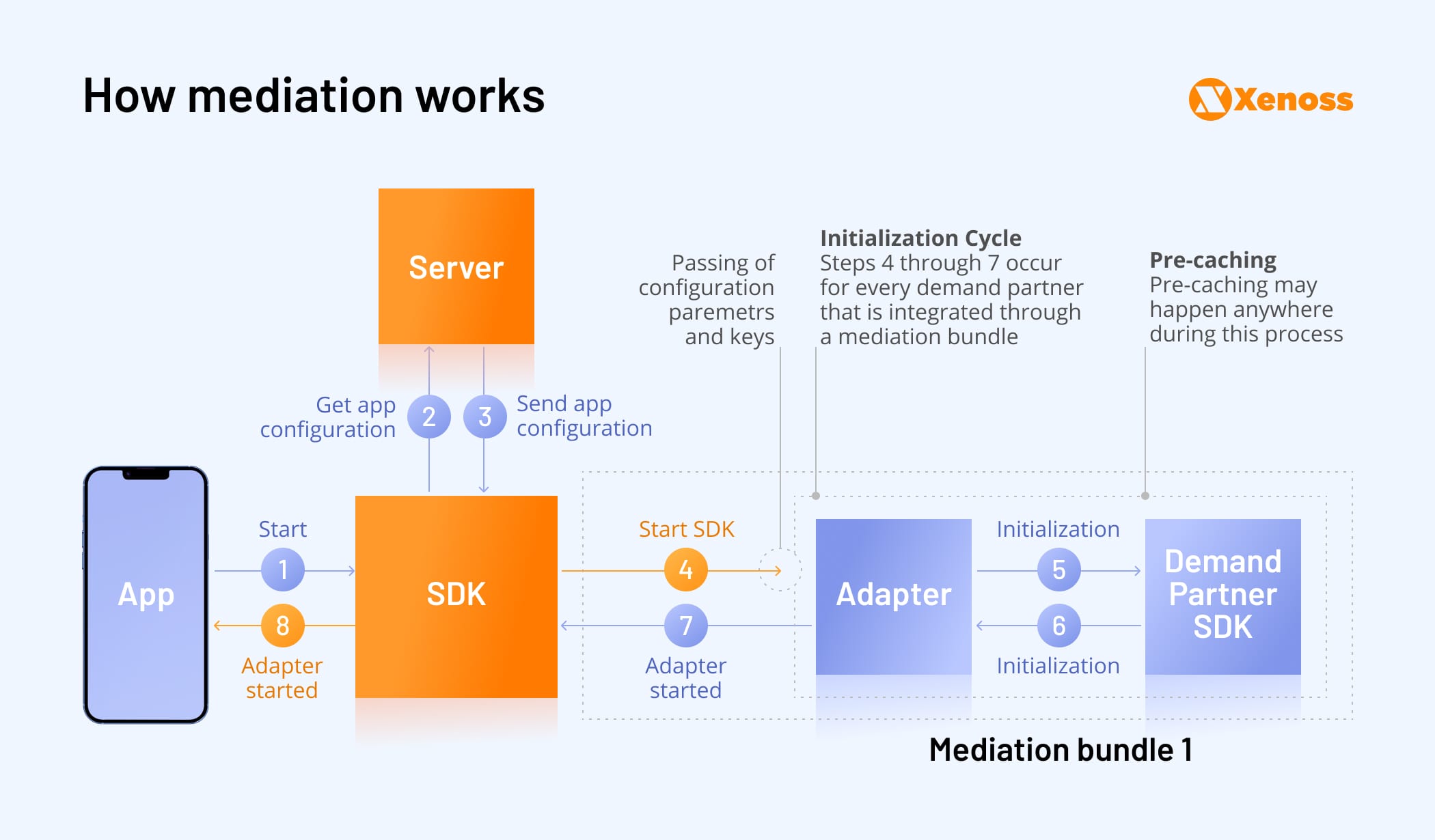
With mobile ad mediation, you can improve your mobile app games monetization by routing requests to multiple ad networks to connect you with the highest bidder. A mobile ad mediation SDK acts as a judge and determines at which position each advertiser starts the chase – prioritizing and ordering ad networks according to total potential ad revenue.
Advantages of a mobile ad mediation platform:
- Orchestrated access to multiple ad networks from one connector (SDK).
- Major distribution scale – you can add more ad partners without undermining the technical app performance.
- Unified data collection and analytics, enabling a 360-degree view of your inventory performance.
- Unified reporting that provides data on CTRs and CPMs, based on app type, user demographics, geolocation, etc.
Instead of connecting multiple ad networks, you can use one SDK to rule them all and benefit from some extra features such as advanced analytics, convenient reporting, fraud detection, and so on. There are myriads of mediation solutions on the market, with every major ad holding having some stake in the game.
Popular mobile ad mediation platforms:
While ad mediation solutions resolve the critical issue of scale and relieve publishers of the cumbersome integration of individual ad networks, they come with some problems of their own.
Challenges of SDK ad mediation
Most game developers monetize mobile games with several SDKs to seize more potential demand from different ad networks.
Having multiple SDKs (advertising or not) inside your gaming app undermines its performance. Each SDK consumes considerable device resources, leading to app glitches, frozen screens, and other UX bugs. User experience suffers from every SDK you integrate – and lagging app performance will eventually make users churn.
Mobile apps use 18 third-party SDKs on average. The number is even higher for gaming apps. And it’s hard for developers to estimate the number of resources used by each SDK once the app goes to production.
Besides consuming resources, ad network connectors also have more than a few conflicting technical requirements.
If two ad networks use different versions of the adaptor, you won’t be able to integrate both of them in your app because of interoperability issues. And once again, you risk losing users and in-app advertising revenues.
Risks of using multiple SDKs for mobile game monetization:
- Conflicting requirements between SDKs and interoperability issues
- High maintenance costs since you need to frequently update the infrastructure
- App performance issues due to higher demand for device resources
- Lack of end-to-end visibility into monetization
- Inability to program custom eCPM requirements for different ad networks
- Difficulty in harmonizing different versions of connectors
- Unity game engine doesn’t pair well with many ad network SDKs
In other words: Without proper mobile ad mediation, you don’t have a mechanism for governing ad bid selection, and conditions for calling a different network to ensure high fill rates.
You are not just leaving ad money on the table – you are paying the price in the form of lost users and higher mobile game maintenance costs. That’s why a mediation platform is an absolute prerequisite nowadays for effective app monetization. Publishers just need to decide whether they should go with an off-the-shelf mediation or build their own ad suite.
How to choose an ad mediation solution?
There’s no shortage of providers on the market. However, it would be best if you considered the tradeoffs each has.
The role of an ad mediator is to cherry-pick the highest bids from different demand sources and pitch you the highest bid first. In practice, not every off-the-shelf ad mediation platform works this way.
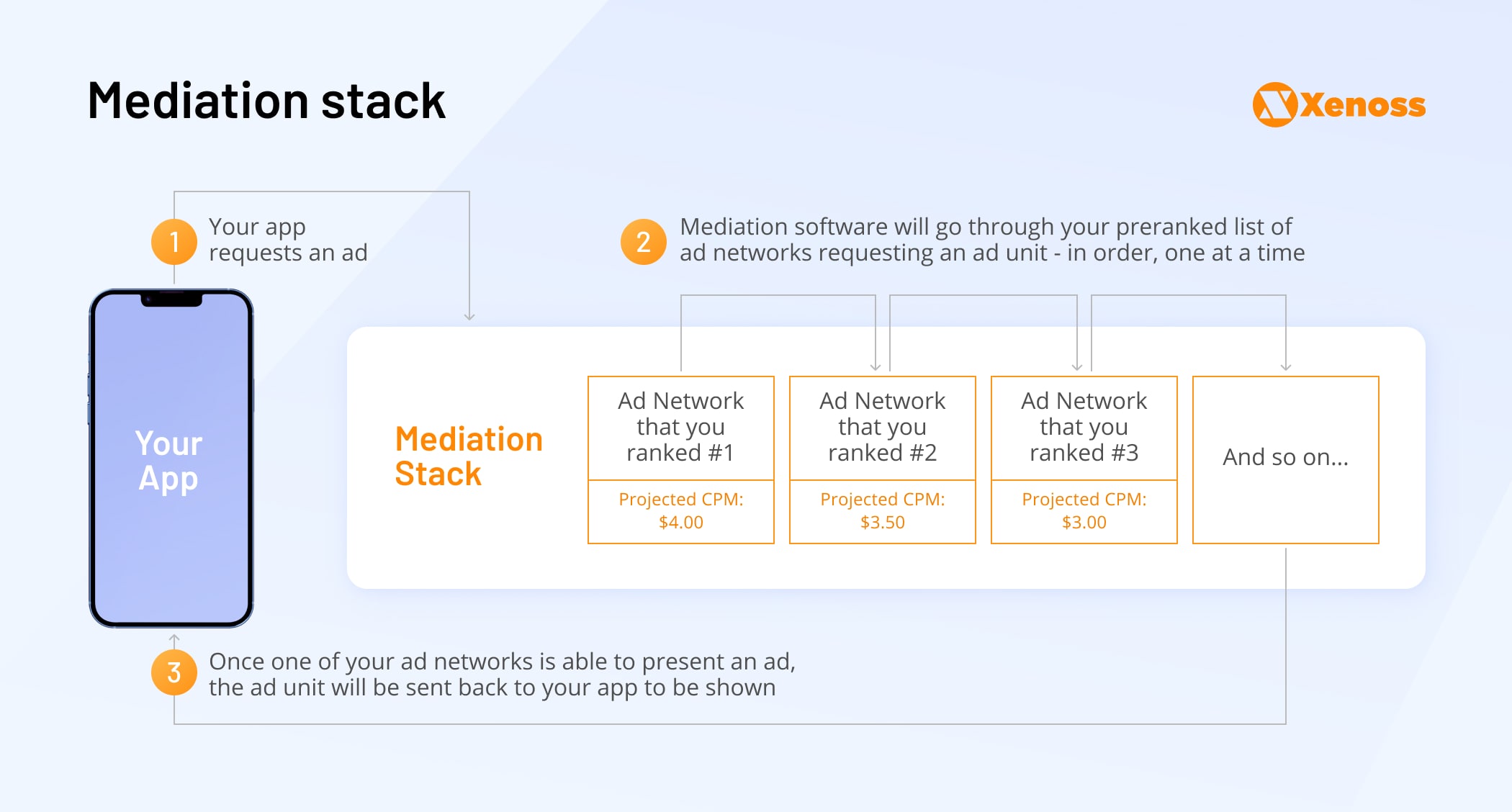
Limitations of ad meditation platforms
First, many ad mediation platforms are operated by ad networks. They often try to sneak in their network (over a competing one) even if their offer isn’t the best. But keeping tabs on your ad slots is hard when you have a large inventory and sell it out to several demand sources. You can prevent this with more advanced eCPM controls.
Next, some legacy ad mediation solutions use the waterfall methodology. In this case, the solution first passes the ad opportunity to one ad network to bid. If the network doesn’t respond, the call goes to the second one, and so forth until the waterfall is exhausted.
As a publisher, you can optimize the bidding process by adding custom controls to rank different ad networks in terms of their efficiency. But it still won’t be real-time bidding (RTB).
[cta-with-description title=”Looking for experienced AdTech engineers and integrators for your team? ” description=”Get in touch to see how Xenoss can help to strengthen your in-house expertise.” url=”” buttontext=”Contact us”]
In the pure mediation setup, advertisers can’t place bids in real-time to win over available impressions at the maximum price. That being said, some mobile ad mediators recently upgraded their stack to support the mobile version of header bidding.
Unlike mediation, RTB bidding allows mobile app publishers to offer their inventory to many demand partners at once. Unlike waterfall, the highest (not the first) bid wins.
Your header bidding platform ought to have done the work of aggregating demand partners for your ad inventory, which means that it should be a one-stop-shop rather than the forcing of numerous SDK implementations from your development team.
Debra Fleenor, president of Adapex.
However, not all out-of-the-box mobile ad mediation platforms support bidding or integrate with the DSPs and SSP auctions you want to use.
To avoid the limitations of the mainstream platforms, large mobile app publishers choose to develop custom mobile ad mediation solutions instead.
Benefits of building a custom mobile ad mediation platform for mobile game monetization
As an AdTech development partner, we know first-hand how vast the advertising technology landscape is.
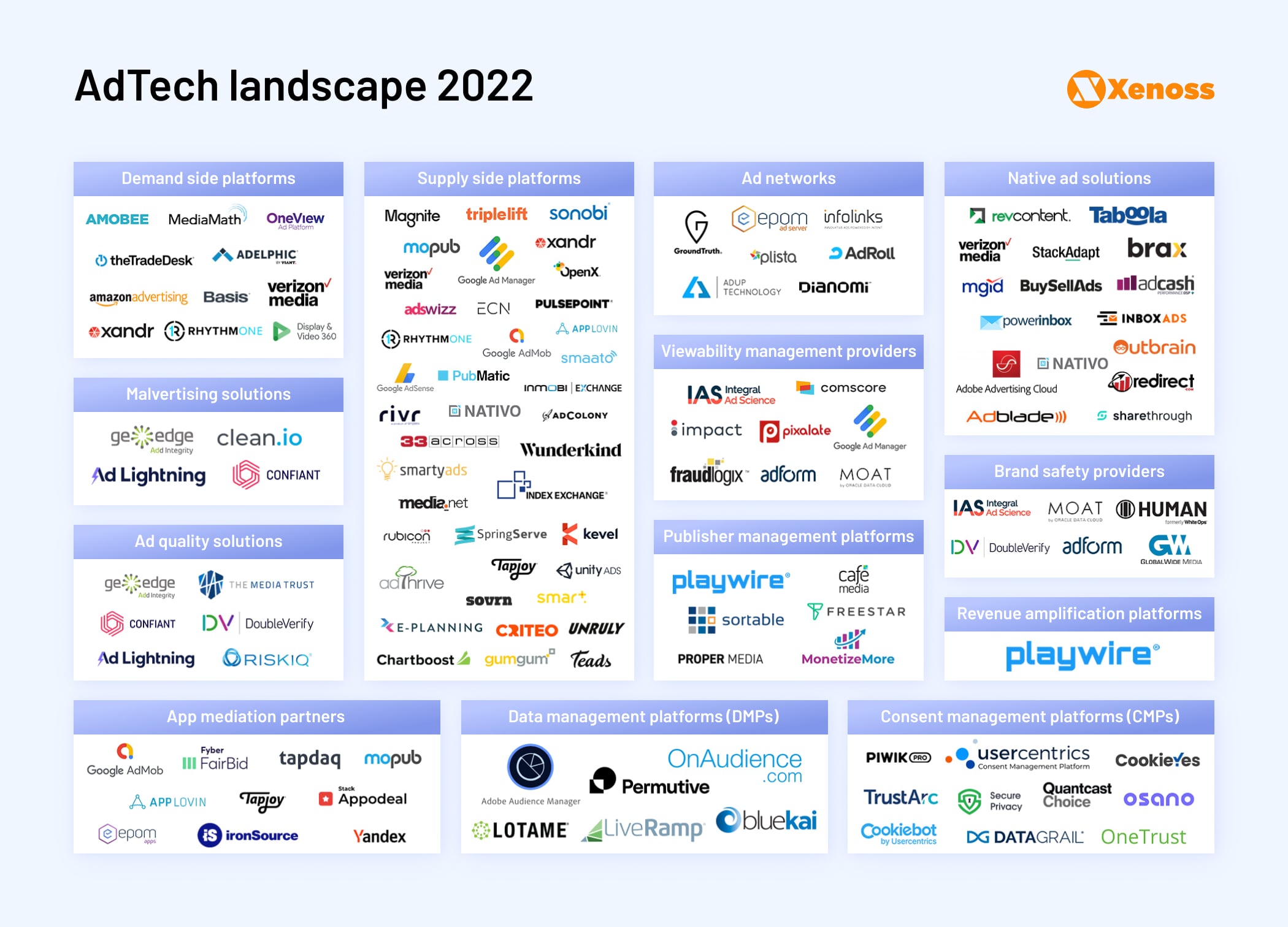
This expansive environment means two things:
- Advertisers use a collection of DSPs, ad networks, and ad exchanges to diversify their reach.
- Publishers as well utilize several SSPs and ad networks for their inventory.
The critical problem for publishers is that one advertising solution can’t satisfy all your mobile app games monetization needs.
Ad mediation solves the problem of accessing multiple networks through one SDK. But few platforms provide access to bidding and advanced programmatic selling models such as private deals or private auctions. Even fewer solutions support new advertising formats such as native personalized in-game advertising.
When the publisher receives the bid response from the auction, oftentimes determining the ad type is problematic. Most ad suites lack capabilities to automate this task and require additional manual procedures to ensure proper ad serving — the quality and suitability of the creative for the ad slot.
Bohdan Rehulich, Delivery Manager at Xenoss
Also, by using multiple partners, you end up with fragmented ad performance analytics, leaving you with a scattered picture of ad slot performance. A custom solution can address the shortcomings of mobile ad mediation. Here’s how.
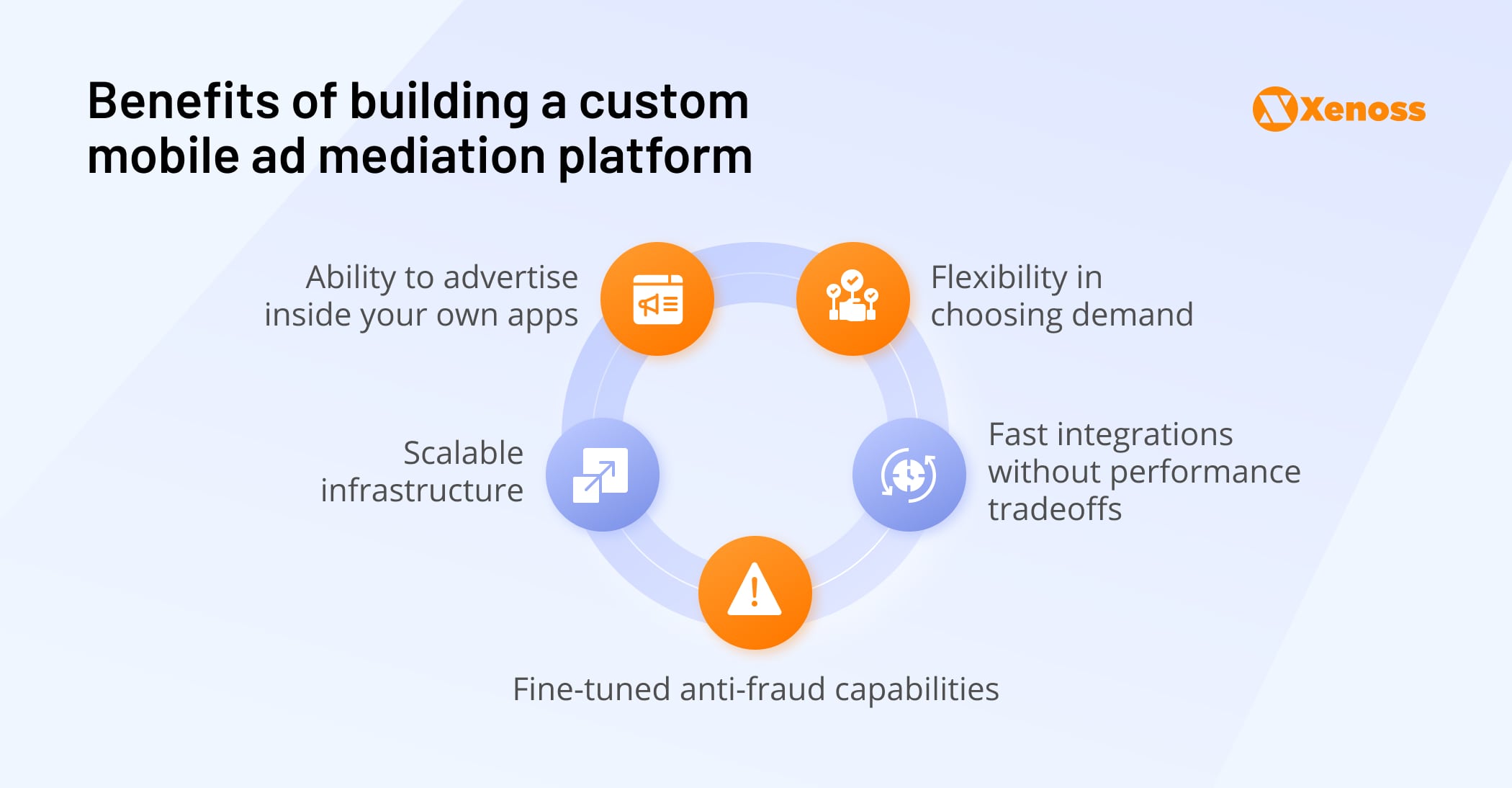
Flexibility in choosing demand
Publishers have plenty of options for mobile games monetization.
Besides choosing various gaming ad formats, you can also codify different buying conditions for different creative types and inventory assets.
With a custom ad mediation platform, you can do private deals for the most in-demand placements. Then auction the remaining inventory via RTB or through the waterfall of ad mediation to capture all available demand.
The best part? You can assemble your own ecosystem of ad partners by incorporating connections with different DSPs, SSPs, and individual ad exchanges. You can also operate a separate purchase path for premium advertisers looking for direct deals and “special treatment.”
After changing the ad mediation platform, working on the waterfall optimization brought an increase of 15% in eCPM for the different ad placements on both OS (AND & iOS US, Banners, RV & IS).
Victor Vielliard of Homa Games
The custom mediation solution also ensures that ads served via different routes don’t overlap or overwhelm users. Apps get unique demand, while gamers stay in love with your product.
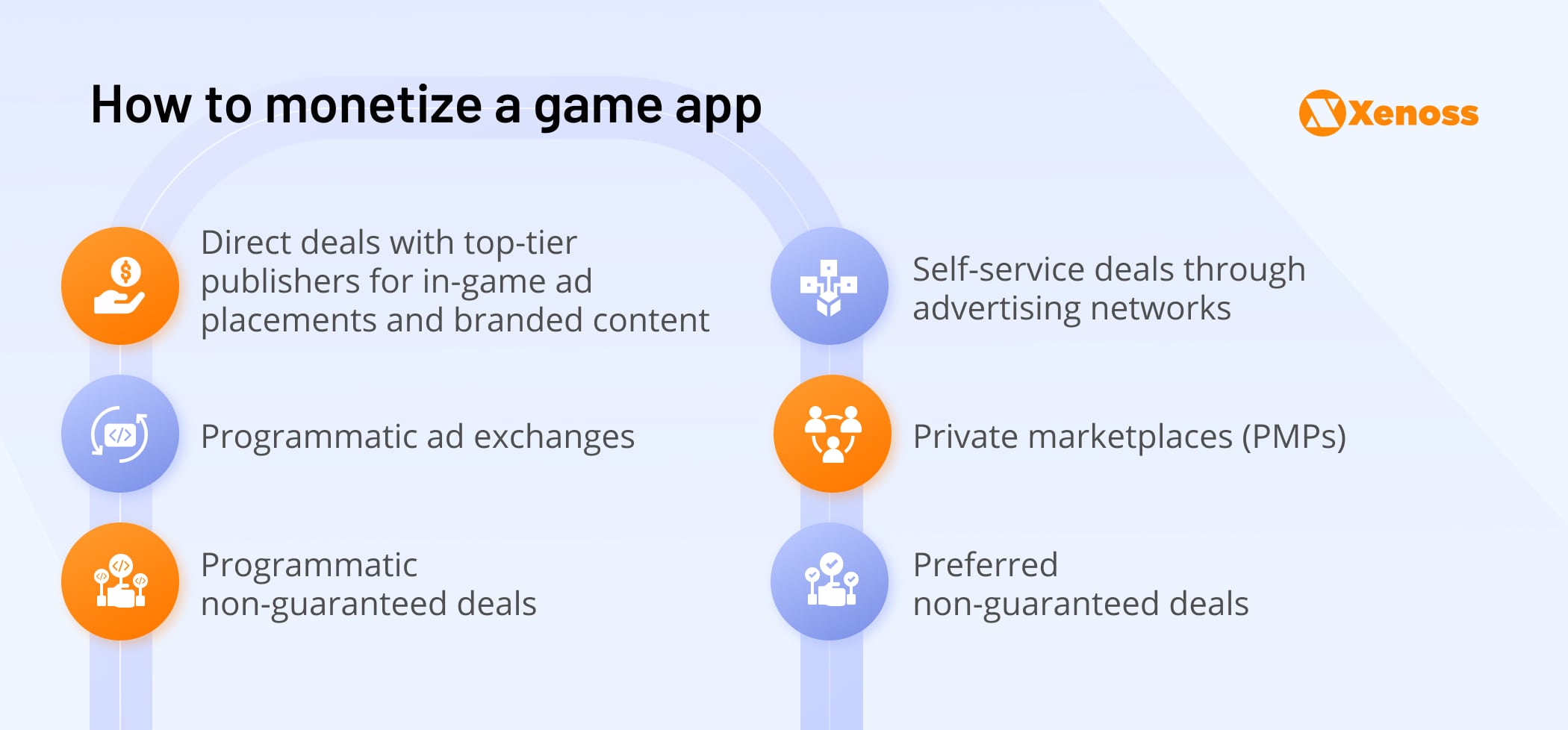
By combining different game monetization strategies, you reduce your reliance on a single provider. Sure, established players like AdMob can guarantee the fill rate for your game ads inventory. But what if they ban your app one day because it breaks their policy? Your revenue will dry up in seconds. That’s risk diversification 101.
Advertisers don’t put all their budgets into one platform either. As recent data suggests, in-app private marketplaces saw a 65% spike in ad volumes during Q1 of 2020, whereas in-app volume for RTB on open markets dropped by 15%. Such shifts in spending are hardly an outlier.
To have access to all available demand, you need the capabilities to leverage private marketplaces. By operating a custom ad mediation platform, you can always “go where you are treated best” and ensure high fill rates at all times.
Fast integrations without app performance tradeoffs
As mentioned earlier, channeling demand via one ad mediation SDK is less disruptive for user experience.
By “wrapping” individual ad network connectors in a custom ad mediation SDK, you don’t have to deal with:
- Extra downloading size, which makes your app “heavy” for users on older devices
- Game stability risks, due to interoperability issues between ad networks
- In-app UX issues, resulting from poor ad placements and incorrect rendering
Instead of having a spaghetti of cords, you use one “master-plug” to channel advertisers into your products.
You can (and should!) standardize your ad mediation SDK to all the apps in your portfolio. When you have up-to-date tech requirements, you won’t have to reengineer your product each time you want to add a new network.
You can also unify standards for all supported native ad formats and add granular controls over ad serving. Then progressively tweak these to ensure that each type of mobile ad placement – from app-wall promotions to native in-game video ads – performs at its finest and delivers powerful ROAS to advertisers.
For instance, the Xenoss development team recently helped Venatus implement a holistic analytics platform for its ad inventory. The team now has access to consolidated reporting from 900 publishers they run and can clearly see all the performance metrics for different types of inventory. And we can create similar cataloging and analytics solutions for mobile app publishers too!
[cta-with-description title=”Contemplating building your own ad mediation?” description=”Discuss it with a tech advisor to determine if it is right for you.” url=”” buttontext=”Contact us”]
Access to first-party data
Data is the life-blood of the mobile advertising world. The more you know about your users — from basic demographics stats to common behaviors and responses to different creative formats – the more attractive ad deals you can broker.
Likewise, seeing first-party data from advertisers can help you optimize your ad placements and serving experience.
With a custom solution, you can retain your in-game analytics and collect first-party user data:
- Device type
- Operating System (OS)
- Geoinformation
- Demographic information
- Average revenue per user
- Behavioral data
Infusing these data into the ad request will significantly increase the DSPs’ ability to evaluate the offered opportunities. It’s also a solid way to dispel any concerns regarding the quality and authenticity of impressions and actions across your inventory.
Fraud prevention
Advanced analytics not only helps you impress advertisers. It also helps improve programmatic fraud detection. Ad networks are a lucrative target for fraudsters, but uncovering them is problematic due to the lack of transparency in the supply chain.
By operating your custom ad mediation platform, you can implement a set of “checkpoints” against common types of fraud, which slip into your app via ad networks. Essential ad fraud detection and prevention solutions include:
- Invalid Traffic detection and filtration
- Bot blocking
- SDK spoofing prevention
- Statistic-based anomaly detection
- Fact-based anomaly detection
Also, by adding comprehensive analytics, you can quickly locate instances of bidding on ghost inventory generated by a malicious party siphoning off your profits.
Scalable infrastructure
Popular ad mediation platforms are furnished with a set of ad networks and DSPs. Some allow adding custom connectors. Others charge extra licensing fees for that or don’t support any customization, limiting your options.
From a technology standpoint, ad mediation platforms must have stable performance and high load tolerance since they process millions of bid requests. When something goes awry on their end, e.g., there’s unplanned downtime, you can’t do anything to resolve the issue faster.
A custom solution gives you complete control over supporting infrastructure. You also get to optimize it for maximum performance at a minimal cost.
For Aequus, an ad mediation platform, we build a high-performance, scalable infrastructure capable of processing 200 queries per second (QPS) for under $10K per month.
Ability to advertise inside your own apps
We kept the sweetest bite for last. By owning your custom ad mediation platform, you can effectively cross-promote your own titles within your network.
Since you have complete analytics, you can give your apps the best ad placements in your inventory whenever you need to boost user numbers – and pay zero cents for that. Or you can auto-fill vacant ad spots with your titles if no advertiser currently bids above your eCPM.
In other words: You always keep your fill rates at max capacity, either by putting out the best ad offers or by spinning your titles for free.
Best practices for building an ad suite for mobile games monetization
Operating your custom ad mediation platform has numerous advantages. But it also means extra development costs. Lack of expertise and possibly a high implementation budget deter many publishers from building their proprietary ad suites.
These concerns have their merit, but as our partnership with Aequus proved, you can deploy a fully-functional mobile ad mediation SDK in 3 months. To ensure that your mobile meditation solution can be quickly deployed and seamlessly scaled, you need to follow the industry’s best practices.
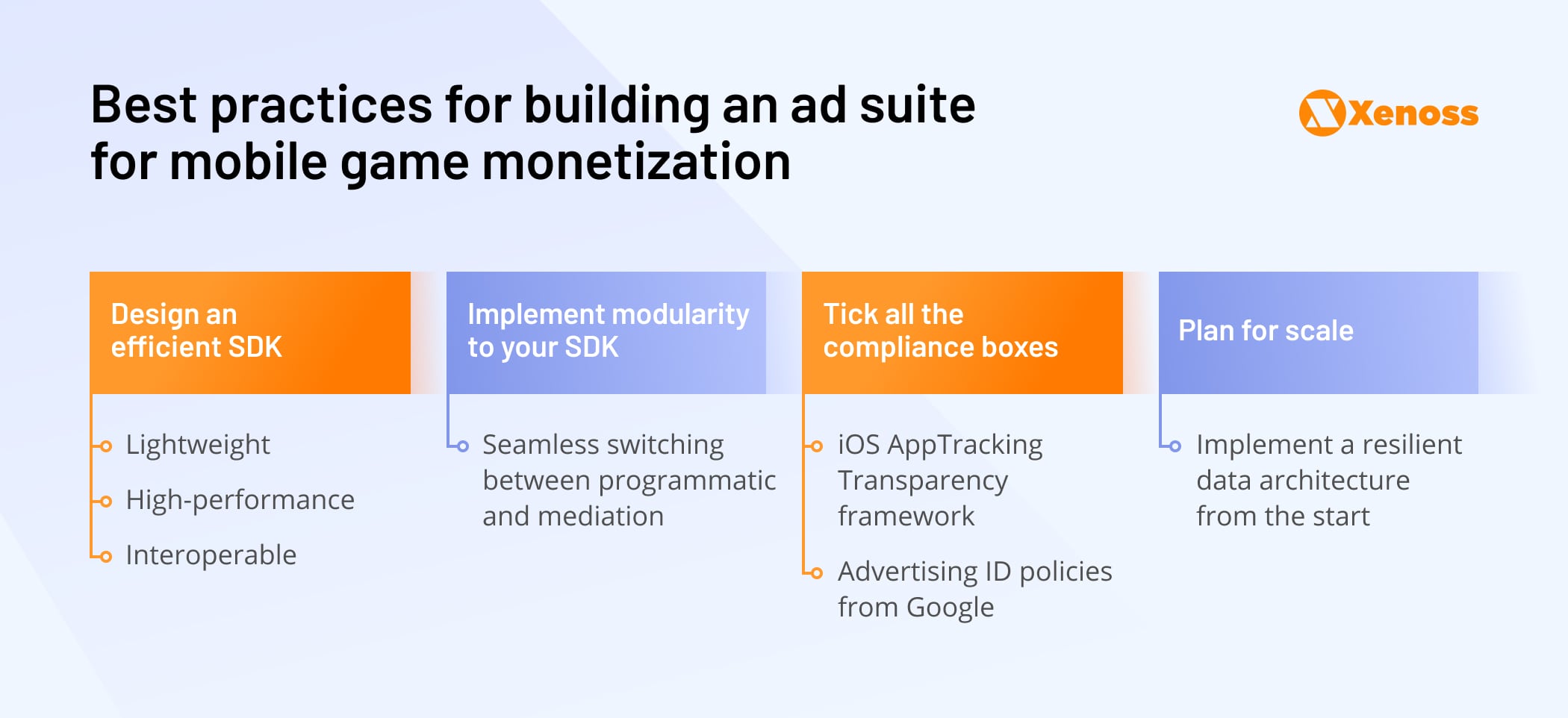
Design a high-performance SDK
A mobile software development kit (SDK) is a collection of tools for easy integration of advertising products into the mobile app.
A proper mobile ad mediation SDK has to be:
- Lightweight: Have the minimally necessary amount of code
- High-performance: Consume just the right amount of resources
- Simple to integrate: You can easily add it to different types of apps
- Bug-free: Tested to perfection to avoid any lags and mismatches
- Secure: Your SDK transmits sensitive data so it should be well-protected
- Interoperable: It doesn’t interfere with any non-advertising SDKs you use for your apps
Finally, it has to perform on-point mediation – daisy chain all partners in the right order and allow you to switch between ad networks, SSP auctions, and direct demand from DSPs.
These are the principles we used for building the Aequus ad mediation SDK. It’s lite, high-performing, and can be installed into new products without any tweaks. On the routing side, the SDK connects to an ecosystem of 15 bidding SDKs and 10 ad network SDKs.
Add modularity to your SDK
Savvy mobile app publishers monetize their products via both direct demand and mediation. The goal of your platform is to ensure seamless switching between the two options.
We usually configured a separate “lane” for direct demand deals with a robust creative rendering engine for serving popular ads in VAST and MRAID formats. Separately, we allow publishers to plug into ad serving networks either via the same SDK or by installing a network-specific plugin that provides access to it.
Tick all the compliance boxes
One of the primary goals of an SDK is to channel data between publishers and advertisers (and all ecosystem partners in between).
As mentioned earlier, you may want to share some extra user data with advertisers. However, it would be best to do so with security and compliance in mind.
Therefore, your ad mediation solution must be compatible with:
For staying within the legal framework, it is absolutely critical to respect the users’ decision to opt out from data sharing for personalization on iOS and Android.
Plan for scale
Finally, an SDK is just part of an ad mediation platform. It would help if you also had high-load architecture to power data processing on the backend. Cloud technology is the obvious choice here, thanks to its instant elasticity.
However, limitless resource provisioning can also significantly increase the platform’s operational costs without improving the performance if there are bottlenecks in your architecture design.
In one of our projects, we identified potential constraints in technical architecture, and suggested an optimized tech stack and design principles that increased the system’s performance by 10X without significantly growing the operational costs.
Final thoughts
Game publishers have already profited from significant growth in user numbers and daily engagement rates. Now it’s time to take advantage of expanding mobile ad budgets. Ad mediation helps you integrate more ad networks into your app without risking the churn rate.
At the same time, a custom platform provides you with virtually limitless possibilities for combining different types of demand partners, selling methods, and creative formats. You also get a unique opportunity to cross-promote your own titles for free to create a closed-loop ecosystem for growth at all ends.
Xenoss can advise you on expanding your existing technical capabilities or assist you with building your own ROI-driven mobile game advertising solution.
